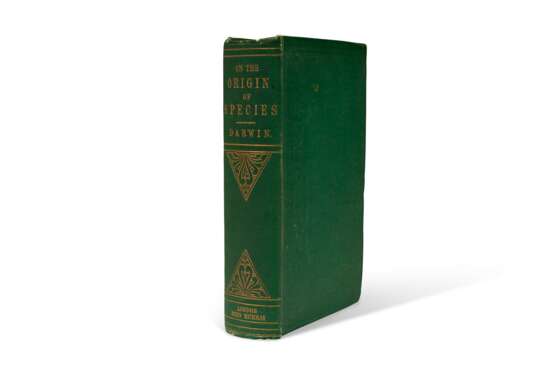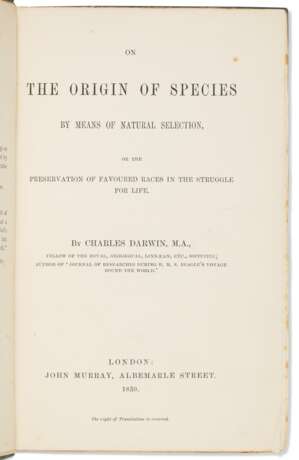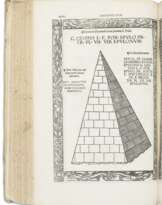ID 627525
Lot 35 | Origin of Species
Estimate value
$ 150 000 – 250 000
Fine first edition of "the most important single work in science" (Dibner). "A turning point, not only in the history of science, but in the history of ideas in general" (DSB). Although some key observations and findings from the voyage of the Beagle acted as his initial inspiration, Darwin’s ideas about the beneficial mutation of species did not cohere into the theory of evolution until his reading of Thomas Malthus’s Essay on the Principle of Population in 1838. The gestation of the theory was slow, but in 1856, following a conversation with Sir Charles Lyell about his hypothesis, Darwin was determined to bring it to a conclusion. Two years later he had composed an extended treatise entitled "Natural Selection," two-thirds complete at 250,000 words. Then in June 1858 Darwin received a letter about evolution from Alfred Russel Wallace, who had independently arrived at similar conclusions. The two scientists issued a joint paper on the subject at the Linnean Society on 1 July. Darwin was now forced to publish and, urged on by Hooker, he condensed his big book into an "abstract" of some 155,000 words. "The book, stripped of references and academic paraphernalia, was aimed not at the specialists, but directly at the reading public." Finally published as On the Origin of Species on 24 November 1859 in a print run of 1250 copies, the work expounded a theory of evolution that was recognizably superior and of infinitely greater impact than all previous hypotheses explaining biological diversity. Dibner Heralds (1980) 199; Freeman 373; Garrison-Morton (1991) 220; Grolier English 193; Grolier Science 23b; Norman 593; PMM 344b; Sparrow Milestones 49; Waller 10786.
Octavo (197 x 124 mm). Half-title, folding lithographic diagram; 32-page list of John Murray's books at end dated June 1859. Publisher's green cloth, covers stamped in blind, spine lettered and decorated in gilt, brown coated endpapers, with the ticket of Edmonds & Remnants of London [Freeman binding variant a] (hinges weak and showing, light spotting to fore-edge, few pencil erasures to flyleaves); custom clamshell (faded). Provenance: gift inscription dated December 1859 to front flyleaf, contemporary marginalia on the deafness of blue-eyed cats on p. 12 – Julius H. Cohn, purchased in New York c.1929 – by descent to Theodore Cohn.
| Artist: | William Shakespeare (1564 - 1616) |
|---|---|
| Applied technique: | Pencil |
| Artist: | William Shakespeare (1564 - 1616) |
|---|---|
| Applied technique: | Pencil |
| Address of auction |
CHRISTIE'S 8 King Street, St. James's SW1Y 6QT London United Kingdom | |
|---|---|---|
| Preview |
| |
| Phone | +44 (0)20 7839 9060 | |
| Buyer Premium | see on Website | |
| Conditions of purchase | Conditions of purchase |













